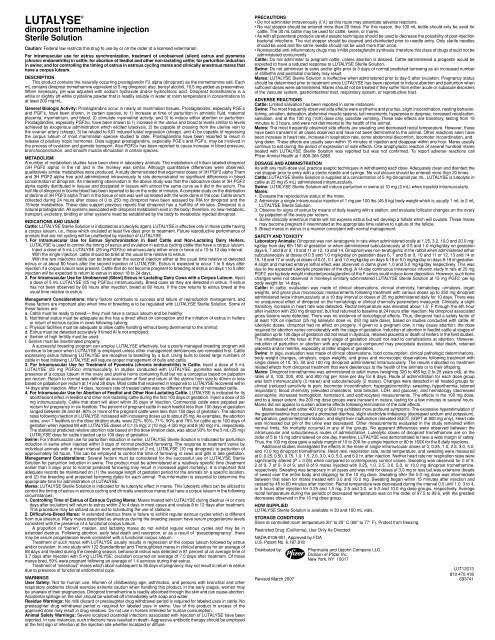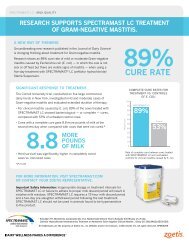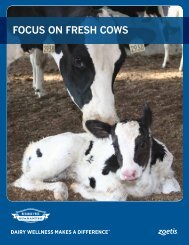Heifer Synchronization - Zoetis
Heifer Synchronization - Zoetis
Heifer Synchronization - Zoetis
You also want an ePaper? Increase the reach of your titles
YUMPU automatically turns print PDFs into web optimized ePapers that Google loves.
LutaLyse ®<br />
dinoprost tromethamine injection<br />
sterile solution<br />
Caution: Federal law restricts this drug to use by or on the order of a licensed veterinarian.<br />
For intramuscular use for estrus synchronization, treatment of unobserved (silent) estrus and pyometra<br />
(chronic endometritis) in cattle; for abortion of feedlot and other non-lactating cattle; for parturition induction<br />
in swine; and for controlling the timing of estrus in estrous cycling mares and clinically anestrous mares that<br />
have a corpus luteum.<br />
DesCRIPtION<br />
This product contains the naturally occurring prostaglandin F2 alpha (dinoprost) as the tromethamine salt. Each<br />
mL contains dinoprost tromethamine equivalent to 5 mg dinoprost: also, benzyl alcohol, 16.5 mg added as preservative.<br />
When necessary, pH was adjusted with sodium hydroxide and/or hydrochloric acid. Dinoprost tromethamine is a<br />
white or slightly off-white crystalline powder that is readily soluble in water at room temperature in concentrations to<br />
at least 200 mg/mL.<br />
General Biologic activity: Prostaglandins occur in nearly all mammalian tissues. Prostaglandins, especially PGE’s<br />
and PGF’s, have been shown, in certain species, to 1) increase at time of parturition in amniotic fluid, maternal<br />
placenta, myometrium, and blood, 2) stimulate myometrial activity, and 3) to induce either abortion or parturition.<br />
Prostaglandins, especially PGF2α, have been shown to 1) increase in the uterus and blood to levels similar to levels<br />
achieved by exogenous administration which elicited luteolysis, 2) be capable of crossing from the uterine vein to<br />
the ovarian artery (sheep), 3) be related to IUD induced luteal regression (sheep), and 4) be capable of regressing<br />
the corpus luteum of most mammalian species studied to date. Prostaglandins have been reported to result in<br />
release of pituitary tropic hormones. Data suggest prostaglandins, especially PGE’s and PGF’s, may be involved in<br />
the process of ovulation and gamete transport. Also PGF2α has been reported to cause increase in blood pressure,<br />
bronchoconstriction, and smooth muscle stimulation in certain species.<br />
MetaBOLIsM<br />
A number of metabolism studies have been done in laboratory animals. The metabolism of tritium labeled dinoprost<br />
(3H PGF2 alpha) in the rat and in the monkey was similar. Although quantitative differences were observed,<br />
qualitatively similar metabolites were produced. A study demonstrated that equimolar doses of 3H PGF2 alpha Tham<br />
and 3H PGF2 alpha free acid administered intravenously to rats demonstrated no significant differences in blood<br />
concentration of dinoprost. An interesting observation in the above study was that the radioactive dose of 3H PGF2<br />
alpha rapidly distributed in tissues and dissipated in tissues with almost the same curve as it did in the serum. The<br />
half-life of dinoprost in bovine blood has been reported to be on the order of minutes. A complete study on the distribution<br />
of decline of 3H PGF2 alpha Tham in the tissue of rats was well correlated with the work done in the cow. Cattle serum<br />
collected during 24 hours after doses of 0 to 250 mg dinoprost have been assayed by RIA for dinoprost and the<br />
15-keto metabolites. These data support previous reports that dinoprost has a half-life of minutes. Dinoprost is a<br />
natural prostaglandin. All systems associated with dinoprost metabolism exist in the body; therefore, no new metabolic,<br />
transport, excretory, binding or other systems need be established by the body to metabolize injected dinoprost.<br />
INDICatIONs aND usaGe<br />
Cattle: LUTALYSE Sterile Solution is indicated as a luteolytic agent. LUTALYSE is effective only in those cattle having<br />
a corpus luteum, i.e., those which ovulated at least five days prior to treatment. Future reproductive performance of<br />
animals that are not cycling will be unaffected by injection of LUTALYSE.<br />
1. For Intramuscular use for estrus synchronization in Beef Cattle and Non-Lactating Dairy <strong>Heifer</strong>s.<br />
LUTALYSE is used to control the timing of estrus and ovulation in estrous cycling cattle that have a corpus luteum.<br />
Inject a dose of 5 mL LUTALYSE (25 mg PGF2α) intramuscularly either once or twice at a 10 to 12 day interval.<br />
With the single injection, cattle should be bred at the usual time relative to estrus.<br />
With the two injections cattle can be bred after the second injection either at the usual time relative to detected<br />
estrus or at about 80 hours after the second injection of LUTALYSE. Estrus is expected to occur 1 to 5 days after<br />
injection if a corpus luteum was present. Cattle that do not become pregnant to breeding at estrus on days 1 to 5 after<br />
injection will be expected to return to estrus in about 18 to 24 days.<br />
2. For Intramuscular use for unobserved (silent) estrus in Lactating Dairy Cows with a Corpus Luteum. Inject<br />
a dose of 5 mL LUTALYSE (25 mg PGF2α) intramuscularly. Breed cows as they are detected in estrus. If estrus<br />
has not been observed by 80 hours after injection, breed at 80 hours. If the cow returns to estrus breed at the<br />
usual time relative to estrus.<br />
Management Considerations: Many factors contribute to success and failure of reproduction management, and<br />
these factors are important also when time of breeding is to be regulated with LUTALYSE Sterile Solution. Some of<br />
these factors are:<br />
a. Cattle must be ready to breed— they must have a corpus luteum and be healthy;<br />
b. Nutritional status must be adequate as this has a direct effect on conception and the initiation of estrus in heifers<br />
or return of estrous cycles in cows following calving;<br />
c. Physical facilities must be adequate to allow cattle handling without being detrimental to the animal;<br />
d. Estrus must be detected accurately if timed Al is not employed;<br />
e. Semen of high fertility must be used;<br />
f. Semen must be inseminated properly.<br />
A successful breeding program can employ LUTALYSE effectively, but a poorly managed breeding program will<br />
continue to be poor when LUTALYSE is employed unless other management deficiencies are remedied first. Cattle<br />
expressing estrus following LUTALYSE are receptive to breeding by a bull. Using bulls to breed large numbers of<br />
cattle in heat following LUTALYSE will require proper management of bulls and cattle.<br />
3. For Intramuscular use for treatment of Pyometra (chronic endometritis) in Cattle. Inject a dose of 5 mL<br />
LUTALYSE (25 mg PGF2α) intramuscularly. In studies conducted with LUTALYSE, pyometra was defined as<br />
presence of a corpus luteum in the ovary and uterine horns containing fluid but not a conceptus based on palpation<br />
per rectum. Return to normal was defined as evacuation of fluid and return of the uterine horn size to 40mm or less<br />
based on palpation per rectum at 14 and 28 days. Most cattle that recovered in response to LUTALYSE recovered within<br />
14 days after injection. After 14 days, recovery rate of treated cattle was no different than that of nontreated cattle.<br />
4. For Intramuscular use for abortion of Feedlot and Other Non-Lactating Cattle. LUTALYSE is indicated for its<br />
abortifacient effect in feedlot and other non-lactating cattle during the first 100 days of gestation. Inject a dose of 25<br />
mg intramuscularly. Cattle that abort will abort within 35 days of injection. Commercial cattle were palpated per<br />
rectum for pregnancy in six feedlots. The percent of pregnant cattle in each feedlot less than 100 days of gestation<br />
ranged between 26 and 84; 80% or more of the pregnant cattle were less than 150 days of gestation. The abortion<br />
rates following injection of LUTALYSE increased with increasing doses up to about 25 mg. As examples, the abortion<br />
rates, over 7 feedlots on the dose titration study, were 22%, 50%, 71%, 90% and 78% for cattle up to 100 days of<br />
gestation when injected IM with LUTALYSE doses of 0,1 (5 mg), 2 (10 mg), 4 (20 mg) and 8 (40 mg) mL, respectively.<br />
The statistical predicted relative abortion rate based on the dose titration data, was about 93% for the 5 mL (25 mg)<br />
LUTALYSE dose for cattle injected up to 100 days of gestation.<br />
swine: For intramuscular use for parturition induction in swine. LUTALYSE Sterile Solution is indicated for parturition<br />
induction in swine when injected within 3 days of normal predicted farrowing. The response to treatment varies by<br />
individual animals with a mean interval from administration of 2 mL LUTALYSE (10 mg dinoprost) to parturition of<br />
approximately 30 hours. This can be employed to control the time of farrowing in sows and gilts in late gestation.<br />
Management Considerations: Several factors must be considered for the successful use of LUTALYSE Sterile<br />
Solution for parturition induction in swine. The product must be administered at a relatively specific time (treatment<br />
earlier than 3 days prior to normal predicted farrowing may result in increased piglet mortality). It is important that<br />
adequate records be maintained on (1) the average length of gestation period for the animals on a specific location,<br />
and (2) the breeding and projected farrowing dates for each animal. This information is essential to determine the<br />
appropriate time for administration of LUTALYSE.<br />
Mares: LUTALYSE Sterile Solution is indicated for its luteolytic effect in mares. This luteolytic effect can be utilized to<br />
control the timing of estrus in estrous cycling and clinically anestrous mares that have a corpus luteum in the following<br />
circumstances:<br />
1. Controlling time of estrus of estrous Cycling Mares: Mares treated with LUTALYSE during diestrus (4 or more<br />
days after ovulation) will return to estrus within 2 to 4 days in most cases and ovulate 8 to 12 days after treatment.<br />
This procedure may be utilized as an aid to scheduling the use of stallions.<br />
2. Difficult-to-Breed Mares: In extended diestrus there is failure to exhibit regular estrous cycles which is different<br />
from true anestrus. Many mares described as anestrus during the breeding season have serum progesterone levels<br />
consistent with the presence of a functional corpus luteum.<br />
A proportion of “barren”, maiden, and lactating mares do not exhibit regular estrous cycles and may be in<br />
extended diestrus. Following abortion, early fetal death and resorption, or as a result of “pseudopregnancy”, there<br />
may be serum progesterone levels consistent with a functional corpus luteum.<br />
Treatment of such mares with LUTALYSE usually results in regression of the corpus luteum followed by estrus<br />
and/or ovulation. In one study with 122 Standardbred and Thoroughbred mares in clinical anestrus for an average of<br />
58 days and treated during the breeding season, behavioral estrus was detected in 81 percent at an average time of<br />
3.7 days after injection with 5 mg LUTALYSE; ovulation occurred an average of 7.0 days after treatment. Of those<br />
mares bred, 59% were pregnant following an average of 1.4 services during that estrus.<br />
Treatment of “anestrous” mares which abort subsequent to 36 days of pregnancy may not result in return to estrus<br />
due to presence of functional endometrial cups.<br />
WaRNINGs<br />
user safety: Not for human use. Women of childbearing age, asthmatics, and persons with bronchial and other<br />
respiratory problems should exercise extreme caution when handling this product. In the early stages, women may<br />
be unaware of their pregnancies. Dinoprost tromethamine is readily absorbed through the skin and can cause abortion.<br />
Accidental spillage on the skin should be washed off immediately with soap and water.<br />
Residue Warnings: No milk discard or preslaughter drug withdrawal period is required for labeled uses in cattle. No<br />
preslaughter drug withdrawal period is required for labeled uses in swine. Use of this product in excess of the<br />
approved dose may result in drug residues. Do not use in horses intended for human consumption.<br />
animal safety Warnings: Severe localized clostridial infections associated with injection of LUTALYSE have been<br />
reported. In rare instances, such infections have resulted in death. Aggressive antibiotic therapy should be employed<br />
at the first sign of infection at the injection site whether localized or diffuse.<br />
PReCautIONs<br />
• Do not administer intravenously (I.V.) as this route may potentiate adverse reactions.<br />
• No vial stopper should be entered more than 20 times. For this reason, the 100 mL bottle should only be used for<br />
cattle. The 30 mL bottle may be used for cattle, swine, or mares.<br />
• As with all parenteral products careful aseptic techniques should be used to decrease the possibility of post-injection<br />
bacterial infections. The vial stopper should be cleaned and disinfected prior to needle entry. Only sterile needles<br />
should be used and the same needle should not be used more than once.<br />
• Nonsteroidal anti-inflammatory drugs may inhibit prostaglandin synthesis; therefore this class of drugs should not be<br />
administered concurrently.<br />
Cattle: Do not administer to pregnant cattle, unless abortion is desired. Cattle administered a progestin would be<br />
expected to have a reduced response to LUTALYSE Sterile Solution.<br />
swine: Do not administer to sows and/or gilts prior to 3 days of normal predicted farrowing as an increased number<br />
of stillbirths and postnatal mortality may result.<br />
Mares: LUTALYSE Sterile Solution is ineffective when administered prior to day-5 after ovulation. Pregnancy status<br />
should be determined prior to treatment since LUTALYSE has been reported to induce abortion and parturition when<br />
sufficient doses were administered. Mares should not be treated if they suffer from either acute or subacute disorders<br />
of the vascular system, gastrointestinal tract, respiratory system, or reproductive tract.<br />
aDVeRse ReaCtIONs<br />
Cattle: Limited salivation has been reported in some instances.<br />
swine: The most frequently observed side effects were erythema and pruritus, slight incoordination, nesting behavior,<br />
itching, urination, defecation, abdominal muscle spasms, tail movements, hyperpnea or dyspnea, increased vocalization,<br />
salivation, and at the 100 mg (10X) dose only, possible vomiting. These side effects are transitory, lasting from 10<br />
minutes to 3 hours, and were not detrimental to the health of the animal.<br />
Mares: The most frequently observed side effects are sweating and decreased rectal temperature. However, these<br />
have been transient in all cases observed and have not been detrimental to the animal. Other reactions seen have<br />
been increase in heart rate, increase in respiration rate, some abdominal discomfort, locomotor incoordination, and<br />
lying down. These effects are usually seen within 15 minutes of injection and disappear within one hour. Mares usually<br />
continue to eat during the period of expression of side effects. One anaphylactic reaction of several hundred mares<br />
treated with LUTALYSE Sterile Solution was reported but was not confirmed. To report adverse reactions call<br />
Pfizer Animal Health at 1-800-366-5288.<br />
DOsaGe aND aDMINIstRatION<br />
As with any multi-dose vial, practice aseptic techniques in withdrawing each dose. Adequately clean and disinfect the<br />
vial stopper prior to entry with a sterile needle and syringe. No vial closure should be entered more than 20 times.<br />
Cattle: LUTALYSE Sterile Solution is supplied at a concentration of 5 mg dinoprost per mL. LUTALYSE is luteolytic in<br />
cattle at 25 mg (5 mL) administered intramuscularly.<br />
swine: LUTALYSE Sterile Solution will induce parturition in swine at 10 mg (2 mL) when injected intramuscularly.<br />
Mares:<br />
1. Evaluate the reproductive status of the mare.<br />
2. Administer a single intramuscular injection of 1 mg per 100 lbs (45.5 kg) body weight which is usually 1 mL to 2 mL<br />
LUTALYSE Sterile Solution.<br />
3. Observe for signs of estrus by means of daily teasing with a stallion, and evaluate follicular changes on the ovary<br />
by palpation of the ovary per rectum.<br />
4. Some clinically anestrous mares will not express estrus but will develop a follicle which will ovulate. These mares<br />
may become pregnant if inseminated at the appropriate time relative to rupture of the follicle.<br />
5. Breed mares in estrus in a manner consistent with normal management.<br />
saFety aND tOXICIty<br />
Laboratory animals: Dinoprost was non-teratogenic in rats when administered orally at 1.25, 3.2, 10.0 and 20.0 mg/<br />
kg/day from day 6th-15th of gestation or when administered subcutaneously at 0.5 and 1.0 mg/kg/day on gestation<br />
days 6, 7 and 8 or 9, 10 and 11 or 12, 13 and 14. Dinoprost was non-teratogenic in the rabbit when administered either<br />
subcutaneously at doses of 0.5 and 1.0 mg/kg/day on gestation days 6, 7 and 8 or 9, 10 and 11 or 12, 13 and 14 or<br />
15, 16 and 17 or orally at doses of 0.01, 0.1 and 1.0 mg/kg/day on days 6-18 or 5.0 mg/kg/day on days 8-18 of gestation.<br />
A slight and marked embryo lethal effect was observed in dams given 1.0 and 5.0 mg/kg/day respectively. This was<br />
due to the expected luteolytic properties of the drug. A 14-day continuous intravenous infusion study in rats at 20 mg<br />
PGF2α per kg body weight indicated prostaglandins of the F series could induce bone deposition. However, such bone<br />
changes were not observed in monkeys similarly administered LUTALYSE Sterile Solution at 15 mg PGF2α per kg<br />
body weight for 14 days.<br />
Cattle: In cattle, evaluation was made of clinical observations, clinical chemistry, hematology, urinalysis, organ<br />
weights, and gross plus microscopic measurements following treatment with various doses up to 250 mg dinoprost<br />
administered twice intramuscularly at a 10 day interval or doses of 25 mg administered daily for 10 days. There was<br />
no unequivocal effect of dinoprost on the hematology or clinical chemistry parameters measured. Clinically, a slight<br />
transitory increase in heart rate was detected. Rectal temperature was elevated about 1.5˚ F through the 6th hour<br />
after injection with 250 mg dinoprost, but had returned to baseline at 24 hours after injection. No dinoprost associated<br />
gross lesions were detected. There was no evidence of toxicological effects. Thus, dinoprost had a safety factor of<br />
at least 10X on injection (25 mg luteolytic dose vs. 250 mg safe dose), based on studies conducted with cattle. At<br />
luteolytic doses, dinoprost had no effect on progeny. If given to a pregnant cow, it may cause abortion; the dose<br />
required for abortion varies considerably with the stage of gestation. Induction of abortion in feedlot cattle at stages of<br />
gestation up to 100 days of gestation did not result in dystocia, retained placenta or death of heifers in the field studies.<br />
The smallness of the fetus at this early stage of gestation should not lead to complications at abortion. However,<br />
induction of parturition or abortion with any exogenous compound may precipitate dystocia, fetal death, retained<br />
placenta and/or metritis, especially at latter stages of gestation.<br />
swine: In pigs, evaluation was made of clinical observations, food consumption, clinical pathologic determinations,<br />
body weight changes, urinalysis, organ weights, and gross and microscopic observations following treatment with<br />
single doses of 10, 30, 50 and 100 mg dinoprost administered intramuscularly. The results indicated no treatment<br />
related effects from dinoprost treatment that were deleterious to the health of the animals or to their offspring.<br />
Mares: Dinoprost tromethamine was administered to adult mares (weighing 320 to 485 kg; 2 to 20 years old), at the<br />
rates of 0, 100, 200, 400, and 800 mg per mare per day for 8 days. Route of administration for each dose group<br />
was both intramuscularly (2 mares) and subcutaneously (2 mares). Changes were detected in all treated groups for<br />
clinical (reduced sensitivity to pain; locomotor incoordination; hypergastromotility; sweating; hyperthermia; labored<br />
respiration), blood chemistry (elevated cholesterol, total bilirubin, LDH, and glucose), and hematology (decreased<br />
eosinophils; increased hemoglobin, hematocrit, and erythrocytes) measurements. The effects in the 100 mg dose,<br />
and to a lesser extent, the 200 mg dose groups were transient in nature, lasting for a few minutes to several hours.<br />
Mares did not appear to sustain adverse effects following termination of the side effects.<br />
Mares treated with either 400 mg or 800 mg exhibited more profound symptoms. The excessive hyperstimulation of<br />
the gastrointestinal tract caused a protracted diarrhea, slight electrolyte imbalance (decreased sodium and potassium),<br />
dehydration, gastrointestinal irritation, and slight liver malfunction (elevated SGOT, SGPT at 800 mg only). Heart rate<br />
was increased but pH of the urine was decreased. Other measurements evaluated in the study remained within<br />
normal limits. No mortality occurred in any of the groups. No apparent differences were observed between the<br />
intramuscular and subcutaneous routes of administration. Luteolytic doses of dinoprost tromethamine are on the<br />
order of 5 to 10 mg administered on one day, therefore, LUTALYSE was demonstrated to have a wide margin of safety.<br />
Thus, the 100 mg dose gave a safety margin of 10 to 20X for a single injection or 80 to 160X for the 8 daily injections.<br />
Additional studies investigated the effects in the mare of single intramuscular doses of 0, 0.25, 1.0, 2.5, 3.0, 5.0,<br />
and 10.0 mg dinoprost tromethamine. Heart rate, respiration rate, rectal temperature, and sweating were measured<br />
at 0, 0.25, 0.50, 0.75, 1.0, 1.5, 2.0, 3.0, 4.0, 5.0, and 6.0 hr. after injection. Neither heart rate nor respiration rates were<br />
significantly altered (P > 0.05) when compared to contemporary control values. Sweating was observed for 0 of 9,<br />
2 of 9, 7 of 9, 9 of 9, and 8 of 9 mares injected with 0.25, 1.0, 2.5, 3.0, 5.0, or 10.0 mg dinoprost tromethamine,<br />
respectively. Sweating was temporary in all cases and was mild for doses of 3.0 mg or less but was extensive (beads<br />
of sweat over the entire body and dripping) for the 10 mg dose. Sweating after the 5.0 mg dose was intermediate<br />
between that seen for mares treated with 3.0 and 10.0 mg. Sweating began within 15 minutes after injection and<br />
ceased by 45 to 60 minutes after injection. Rectal temperature was decreased during the interval 0.5 until 1.0, 3 to 4,<br />
or 5 hours after injection for 0.25 and 1.0 mg, 2.5 and 3.0, or 5.0 and 10.0 mg dose groups, respectively. Average<br />
rectal temperature during the periods of decreased temperature was on the order of 97.5 to 99.6, with the greatest<br />
decreases observed in the 10 mg dose group.<br />
HOW suPPLIeD<br />
LUTALYSE Sterile Solution is available in 30 and 100 mL vials.<br />
stORaGe CONDItIONs<br />
Store at controlled room temperature 20° to 25° C (68° to 77° F). Protect from freezing.<br />
Restricted Drug (California), Use Only As Directed<br />
NADA #108-901, Approved by FDA<br />
U.S. Patent No. 6,187,818<br />
Distributed by:<br />
Pharmacia and Upjohn Company LLC<br />
Division of Pfizer Inc.<br />
New York, NY 10017<br />
LUT12013<br />
810 470 418<br />
Revised March 2007 693741










